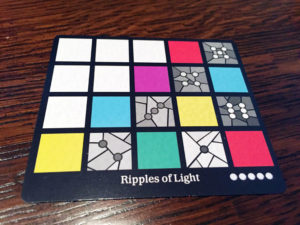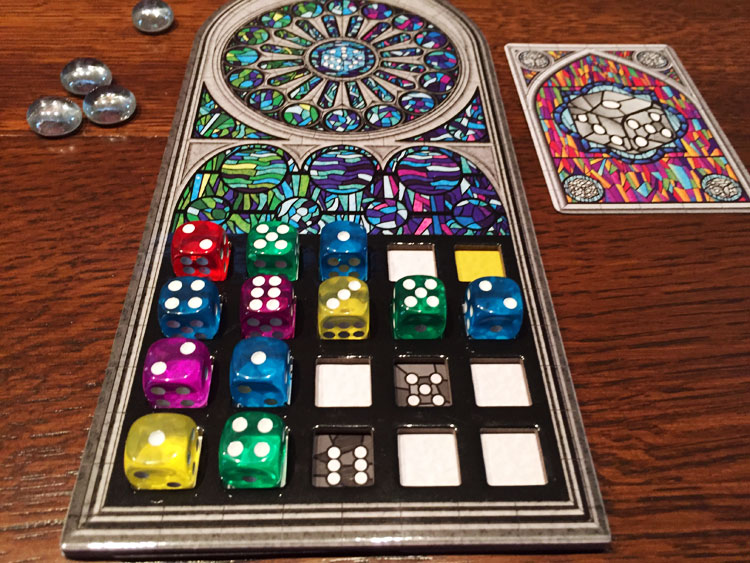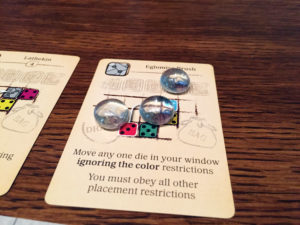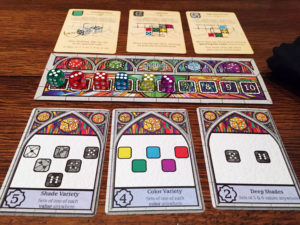 I will be the first person to complain about “the good old days” when Gen Con, at least from a board gaming perspective, was more about game demos and new game releases and less about previewing a Kickstarter campaign that will launch “soon” or “in early 20xx.”
I will be the first person to complain about “the good old days” when Gen Con, at least from a board gaming perspective, was more about game demos and new game releases and less about previewing a Kickstarter campaign that will launch “soon” or “in early 20xx.”
That being said, I remember walking by Floodgate Games’ booth on the first day of Gen Con 2016 and stopping just to stare at Sagrada. It was gorgeous. It looked unique. It had many dice.
Despite my “get off my lawn” attitude, I found myself reaching for the Kickstarter pamphlet to see when it was launching its Kickstarter campaign… my bark is much worse than my bite.
Less than one year later, I have the published game and am ready to review it. Ok, fine – sometimes those Kickstarter previews are effective.
Sagrada is “a game of dice drafting & window crafting.” I am quoting this straight from the box because I am not creative. It supports one to four players who are competing to build the best stain glass window. Seriously.
The game base game takes 30 – 60 minutes, depending on the player count and experience with the game.
Gameplay Overview:
Below is a high-level summary of the game; however you can download a pdf of the official rules here.

Sagrada is played over ten rounds, with each round made up of the following three steps:
- The first player randomly draws dice from a dice bag and rolls them to establish the draft pool (two dice for each player plus one)
- Starting with the first player, players may perform each of the following actions in any order (NOTE: Turn order is in a snake draft pattern):
- Draft a die from the draft pool and place the die in his window
- Use a tool card which allows the use of special abilities, but for a price (favor tokens)
- After the first player has taken their second turn, the round is over
The next round starts with the next player clockwise. After ten rounds, the game is over and the final scores are calculated based on:
- Public objectives
- Private objective
- Favor tokens remaining
- Negative points for each open space in their window
The player with the most points wins.

Game Experience:
I like drafting and I like dice so, unsurprisingly, I liked Sagrada.
The drafting and dice placement is quick yet challenging. You may KNOW what die you want, but finding where to place the die can be challenging, especially as the game progresses and your window begins to fill up with dice. There are several rules that need to be followed when placing dice:
- If the space is white, any die color and number can be placed in that spot
- If the space is colored, any die of that specific color must be placed in that spot
- If the space is numbered, any colored die matching that number can be placed there.
Simple, right? Except that it is not. Once you have placed your first die in the window, which must be on one of the edges of the window, each subsequent die must be placed adjacent (orthogonally or diagonally) to a die that is already in the window. Ok, that’s not so bad… but wait – there is MORE. Any die that is placed may not be placed orthogonally adjacent to a die of the same color OR number. Did I mention that there are exactly twenty spaces in the window? As the game progresses, trying to figure out how to best place a die becomes more difficult as the window fills up.

To balance this, the designers created windows that are rated between three to six on their complexity. The window rating equals the number of favor tokens a player begins with. Favor tokens are used to utilize tools. These tools allow players to break the rules of the game. The more complex your window, the more often you can utilize favor tokens to assist you. Of course, each unused favor token is worth a point at the end of the game, so it is not as simple as using all your favor tokens on tools.
The game also uses randomly chosen public objectives. These objectives score bonus points at the end of the game based on different criteria, such as having sets of dice with certain pips on it or on making rows of dice in which the color of the dice do not repeat. These objectives add another layer to the decision-making process. Should I simply place a die or should I try to complete a public objective, which may limit the choice available due to their restrictions to earn bonus points?
As I stated in the intro, Sagrada is aesthetically pleasing on the table. The dice, their colors, and the different windows look great, especially when they are filled with dice. They simply pop right off the table. Of course, you will want to punch yourself when you have 19 of the 20 spaces filled at the end of the game. If ONLY I had placed that LAST die…
Overall, I found the process of both drafting/figuring out how to place a die as well as whether you should utilize a tool very enjoyable. That being said, I did find a couple of minor issues with the game.
While I am not severely color blind and did not have any issues playing the game, the game is driven by color and being able to differentiate between colors. The game does not provide symbols on the dice to mitigate this potential issue. There were a couple of threads on BGG discussing this issue. There are no symbols used to mitigate what potentially could be a problem for those with color blindness.

My second issue was with the private objectives. At the start of each game, players are dealt one of these objectives face down. There are only five included with the game and they are all the same – add up the values of one of the five colors in the game and that is your private objective. Luckily, you will see your private objective before you select the window you will be completing so you do not get locked into a window that does not match your private objective.
I found these objectives… boring. The points they generate will most likely be your greatest source for points and all it takes is drafting and placing fives or sixes of the color you have. You did this with three fives of your color? BOOM. Fifteen points. Meanwhile, you struggle through the game and manage to complete a row in which no number repeats. Five points.
You could argue that there is the “mystery” of who has which color and potentially hate drafting once you think you have figured out which color is your opponent’s private objective. It just felt like there could be more than five private objectives so that it was not as simple as guessing which color your opponents have. How would that be balanced? What other type of objectives could there be? I do not know. I just know that this part of the game was a minor letdown to me.
Final Thoughts:
Sagrada is a great filler. It is not complex enough to be the main course for the evening, but it is the bacon wrapped dates of fillers. It plays quickly and presents interesting decisions at a brisk pace. Sagrada is also light enough to be played with your non-gamer friends, should you be looking for another gateway game.
Final Score: 3.5 Stars – A visually pleasing and enjoyable light, dice drafting game.
 Hits:
Hits:
• Drafting and dice placing mechanics are very enjoyable
• The game plays quickly and is an excellent filler
• The game is gorgeous on the table
Misses:
• Potential issues for color blind players
• I wish there had been more options for the private objectives























I’ve played this game quite a bit and heartily agree with your review. It’s a fun, fast game, that is easy to learn, but the private objectives just are not interesting. They can win the game for someone based mostly on luck if they get 4 dice with 6 pups of their color. Although, I don’t think this ruins the game, as you still need to place them.
One possible solution I have heard is people just assigning 3 points for each private objective color. This helps to prevent it from being so swingy. But I’ve never tried it.
For the private objectives, It would have been more interesting if you had to incorporate a design into the window, with specific placement of numbers or colors. Or things like “have the most 1 and 2s”.
Anyways, very fun game and a great review!